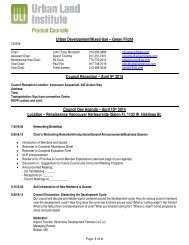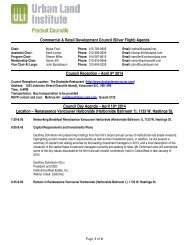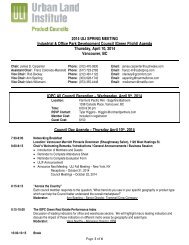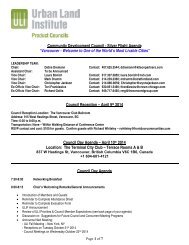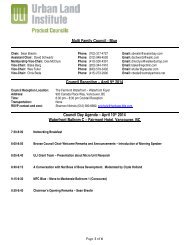Pasco County, FL - Urban Land Institute
Pasco County, FL - Urban Land Institute
Pasco County, FL - Urban Land Institute
You also want an ePaper? Increase the reach of your titles
YUMPU automatically turns print PDFs into web optimized ePapers that Google loves.
• The four components of the development services<br />
branch do not appear to work together.<br />
• The development services branch has been<br />
overwhelmed processing applications and for<br />
the two years since adoption of the comprehensive<br />
plan had no time to restructure or draft its<br />
implementing ordinances.<br />
• The staff of the development services branch is<br />
not conversant with current best practices, is<br />
not provided with consistent training and expressed<br />
low morale.<br />
• The <strong>County</strong> Attorney’s office is delegated to<br />
write development ordinances, but has previously<br />
done so without substantial input from the<br />
development services branch resulting in ordinances<br />
that are poorly understood or not relevant<br />
to the conditions faced by the branch. One<br />
example the panel was told about is a landscaping<br />
ordinance that stipulates plant species unsuited<br />
to local climate conditions.<br />
• The process for determining concurrency proportional<br />
cost allocations to DRIs results in inconsistent,<br />
sometime unrealistic cost allocations<br />
to development rendering the approval process<br />
unpredictable, highly subjective, and taking<br />
many months, if not years, to complete the development<br />
review process.<br />
• The process for reviewing DRI proposals appears<br />
to be disconnected from the county’s comprehensive<br />
plan. Apparently, proposals for DRIs are accepted,<br />
processed, and finalized even though they<br />
may be inconsistent with the comprehensive plan.<br />
DRIs are generally conformed with the comprehensive<br />
plan by special amendment.<br />
• The concurrency proportional cost allocation<br />
discourages redevelopment in older built out areas<br />
in need of revitalization.<br />
The panel has proposed a framework around which<br />
to articulate a vision, mission, and strategic implementation<br />
strategy to guide development that<br />
creates long-term quality of life. Four categories<br />
of action items are offered to translate the county’s<br />
vision into tangible results:<br />
• Match the development management process<br />
to the vision;<br />
• Implement high standards and predictability<br />
into the development review process;<br />
• Strengthen the organizational capacity to manage<br />
the development process; and<br />
• Apply more economic development and revitalization<br />
tools to the development process.<br />
Match the Development Management<br />
Process to the Vision<br />
While the county has the best intentions, it has<br />
not established a clear, concise vision of what the<br />
county wants to be or how it sees its future. Ideas<br />
and concepts are not articulated as a unified vision<br />
or supported by a clear sense of mission and defined<br />
strategies that lead public and private decision<br />
making. As discussed, significant conflicts<br />
exist between many of the county’s development<br />
plans, its implementation methodologies, and its<br />
regulatory actions. While the county administration<br />
has the best intentions, it has not yet formulated<br />
a clear, definable forum in which to create a<br />
mission and develop strategies to implement and<br />
nurture its adopted plans and best practices.<br />
The panel found a disconnection between what is<br />
said in the comprehensive plan and how the administrative<br />
organization and processes implement<br />
the plan. To its credit, the county has gathered<br />
and built excellent information systems and<br />
technological capacity to support the comprehensive<br />
plan. However, it has yet to fully use those<br />
tools in decision making by focusing its development<br />
management principally on new development<br />
within the county’s Central Market Area,<br />
all but ignoring over 50 percent of the population<br />
and hundreds of millions of dollars in existing<br />
infrastructure.<br />
The panel identified five distinct market areas of<br />
the county and has articulated specific vision, mission,<br />
and strategy statements for each. The panel<br />
undertook this task to illustrate the manner in<br />
which visions could be matched with organizational<br />
structure, administrative tools, and staffing to<br />
build consensus and constituency for these distinct<br />
areas. Currently, plan implementation remains in<br />
a reactionary and reactive mode, not yet evolving<br />
into a forward-looking process capable of guiding<br />
34<br />
An Advisory Services Panel Report









